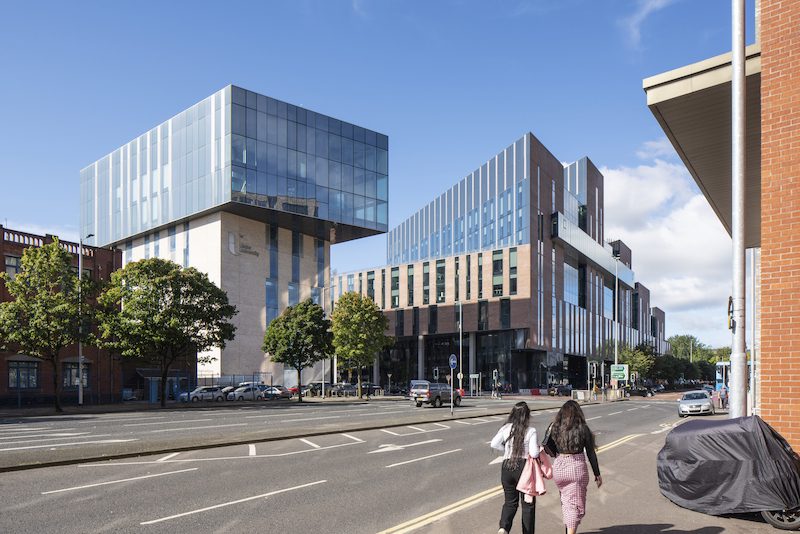In Northern Ireland, Ulster University is rectifying a decision made half a century ago, when they helped devitalize downtown Belfast by opening a new campus in the sprawling suburbs.
In their defense, this was during the height of The Troubles, so they had a better excuse for sprawling than did most schools: student safety.
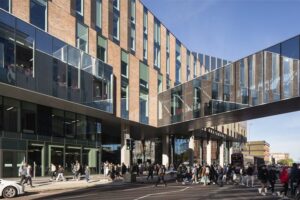 Now though, as Belfast continues its process of revitalizing, Ulster University is doing its part. I (Storm Cunningham) was their about 15 years ago, just as the regeneration was gaining steam, and am happy to see that city leaders aren’t letting the momentum die.
Now though, as Belfast continues its process of revitalizing, Ulster University is doing its part. I (Storm Cunningham) was their about 15 years ago, just as the regeneration was gaining steam, and am happy to see that city leaders aren’t letting the momentum die.
In the Belfast cultural district, the school recently opened a 75,000 square meter addition to their downtown Belfast Campus, which they hope will help revitalize the heart of the long-struggling city.
“This project puts the University in the heart of the intractable issues haunting Northern Ireland’s growth, prosperity and identity,” said Duncan Morrow, Lecturer and Community Outreach Director at the University.
“Education remains a critical path to a better future. This campus, as it twists and turns in the city, is designed to make Higher Education accessible to all,” he added.
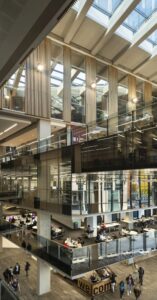 The new buildings are on approximately 1.25 hectares (3.75 acres). The sites were previously occupied by underutilized buildings, a surface car parking lot and a vacant lot.
The new buildings are on approximately 1.25 hectares (3.75 acres). The sites were previously occupied by underutilized buildings, a surface car parking lot and a vacant lot.
Five buildings were demolished to make way for the University, including the Interpoint, Orpheus and Metropol buildings which were previously occupied by office and University uses. The demolished buildings dated from the 1930s through to the 1980s.
This regenerative campus, designed by Feilden Clegg Bradley Studios (FCBS), moves the University’s 1970’s suburban campus in Jordanstown to the city core. The 12-year project houses 16,000 students, faculty and staff in four faculties and departments.
Three new interconnected buildings, delivered across multiple phases, connect to the Belfast School of Art.
This is large for any city, but in Belfast, it proposes a whole new relationship between the city’s educational institutions and the city itself.
This location is at the interface of Belfast’s neglected and still-divided communities, and in walking distance of the economic drivers in the city core and harbor.
This section of the city is eclectic. Historic radial routes intersect with tight lanes and oppressive eight lane road networks.
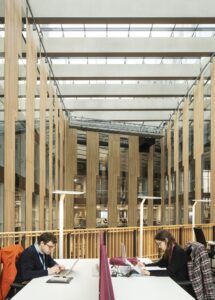 Grand, early 20th century buildings, sheds and terraces occupy the urban blocks.
Grand, early 20th century buildings, sheds and terraces occupy the urban blocks.
The assertively-civic buildings of the University both nestle into historic fabric and challenge the presence of out-scaled road networks.
A three story ‘urban porch’ signals the main entrance on York Street and an openness to the city. Beyond this glazed threshold, a concourse runs the length of the main building connecting visitors and students to cafes, lecture theatres, exhibition spaces and entrances onto other streets and lanes.
A grand stair, using the same stone as the main concourse, ascends past the library, student union and classrooms clad in glass, concrete, and painted wall panels.
The stair turns back on itself and terminates at the base of an extraordinary surprise, a timber and glass clad atrium hangs above you.
This is one of four atria that are like urban squares in plan, that aid in navigation, natural light and organization.
With 14 occupied floors, the campus is vertical. Universities in New York City and large urban campuses across the UK and the continent provided the precedent to cement the project team together and synthesize the vision.
Faculty and administrative offices are organized one above the other around receptions, meeting rooms, conventional and shared offices and the ever-present kitchenette. The large south facing façade looks out across the city and nearby hills.
Vertically stacked here is a huge investment in student hubs designed to bring the entire academic community together and create a 24 hour campus.
A range of social, project and concentrated study spaces are designed to appeal to different needs and personalities.
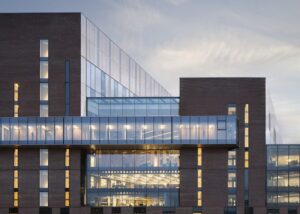 Equally, in a post-COVID academic world, these spaces place a valuable emphasis on being in the room, on being face to face.
Equally, in a post-COVID academic world, these spaces place a valuable emphasis on being in the room, on being face to face.
Belfast is an industrial city at heart and the red brick cladding provides continuity with this identity. The flush glazing and glazed ‘lanterns’ on prominent corners suggest a sculpturally inspired building.
This strong architectural expression is also a sympathetic response to the existing cityscape.
At the junction of the four buildings, a bridge soars overhead and reveals the reconnection of two lanes, disconnected in the 20th century when pedestrian permeability and connection to human scaled spaces was not a priority.
Pro-Vice Chancellor Professor Alastair Adair, wants people to remember that Ulster University is many things. “The project is firstly about education, research and collaboration; collaboration between academics, students, community, industry and government. Our research and educational agendas will continue to foster growth in Northern Ireland. The new building multiplies our impact as it takes its place in both in the city and in the region,” he explains.
These priorities are like those of many Universities across the UK and this may point to a Northern Ireland, that in spite of unresolved social divisions, is finding a space that points definitively forward.
All images courtesy of FCBS.

